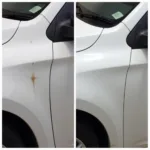Car body repair clamps are essential tools for any auto body technician or DIY enthusiast tackling collision repair. They provide the necessary force and precision to hold panels in place for welding, bonding, or other repairs, ensuring a seamless and professional finish. This guide delves into the different types of car body repair clamps, their applications, and best practices for achieving optimal results.
Types of Car Body Repair Clamps
Choosing the right car body repair clamp depends on the specific task and the type of damage being addressed. Here’s a breakdown of the most common types:
- C-Clamps: These versatile clamps are ideal for holding panels together during welding or bonding. Their adjustable screw mechanism allows for precise pressure control.
- Pinchweld Clamps: Specifically designed for gripping pinch welds, these clamps are crucial for aligning panels and maintaining their shape during repairs.
- Self-Tightening Clamps: Offering quick and easy application, self-tightening clamps are perfect for temporary holding and adjustments.
- Squeeze Clamps: Often used for smaller repairs, squeeze clamps provide a firm grip and are easily maneuvered in tight spaces.
- Multi-Grip Clamps: These adaptable clamps feature adjustable jaws, making them suitable for various shapes and sizes of panels.
Choosing the Right Clamp for the Job
Selecting the correct clamp is crucial for successful car body repair. Consider the following factors:
- Material: Clamps made from high-quality steel offer durability and strength.
- Clamping Force: Choose a clamp that provides sufficient force to hold panels securely without causing damage.
- Reach: The clamp’s reach should be appropriate for the size and shape of the panels being repaired.
- Ease of Use: Opt for clamps that are easy to adjust and operate, especially for intricate repairs.
After this paragraph comes the first image.
Using Car Body Repair Clamps Effectively
Proper usage is key to maximizing the effectiveness of car body repair clamps and ensuring a flawless repair. Here’s a step-by-step guide:
- Prepare the surfaces: Clean and dry the areas where the clamps will be applied to ensure a secure grip.
- Position the panels: Align the panels accurately before applying the clamps.
- Apply the clamps: Distribute the clamps evenly along the repair area, avoiding excessive pressure that could distort the panels.
- Check the alignment: Verify the alignment of the panels after applying the clamps.
- Make adjustments: Fine-tune the clamp pressure as needed to achieve a perfect fit.
Maintaining Your Car Body Repair Clamps
Proper maintenance ensures the longevity and effectiveness of your clamps. Regularly clean the clamps to remove any debris or rust. Lubricate the moving parts to maintain smooth operation. Store the clamps in a dry place to prevent corrosion.
“Regular maintenance is essential for the longevity of your clamps,” says John Smith, a veteran auto body repair specialist. “A little care can save you a lot of money in the long run.”
Common Challenges and Solutions
- Slipping clamps: Use protective pads between the clamps and the panels to prevent slippage and damage.
- Difficult to reach areas: Employ specialized clamps with extended reach or flexible jaws.
- Over-tightening: Gradually increase the clamping pressure to avoid over-tightening and panel distortion.
 Maintaining Car Body Repair Clamps for Longevity
Maintaining Car Body Repair Clamps for Longevity
Conclusion
Car body repair clamps are indispensable tools for achieving professional results in collision repair. Understanding the different types of clamps, their applications, and best practices for usage and maintenance will significantly enhance your repair skills and ensure a flawless finish. By choosing the right clamps and using them effectively, you can achieve lasting and high-quality repairs. Remember, quality tools and proper technique are the keys to successful car body repair.
FAQ
- What type of clamp is best for holding pinch welds? Pinchweld clamps are specifically designed for this purpose.
- How do I prevent clamps from slipping? Use protective pads.
- What material are car body repair clamps typically made of? High-quality steel.
- How often should I maintain my clamps? Regular cleaning and lubrication are recommended.
- What is the most versatile type of clamp? C-clamps are known for their versatility.
- How can I avoid over-tightening clamps? Gradually increase pressure and check alignment.
- Where should I store my clamps? A dry place to prevent corrosion.
“Investing in quality car body repair clamps is an investment in the quality of your work,” advises Maria Garcia, an experienced auto body repair instructor. “Don’t compromise on tools that are essential for precision and durability.”
Need more information on car body repair? Check out our article on araldite metal for car body repair.
Have you ever struggled with warped panels after welding? This can be a sign of improper clamp usage. Explore different clamping techniques to avoid this issue.
For more articles on car repair and maintenance, browse our website.
Need assistance with your car repair project? Contact us via WhatsApp: +1(641)206-8880 or email us at [email protected]. Our customer support team is available 24/7.


